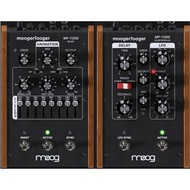Moogerfooger Effects Plug-ins - Moog
by Ellison Wolf
Moog’s line of MoogerFooger pedals have always been a tweaker’s delight. Great modulation options, excellent sound and build quality, and friendly ergonomics made these pedals perhaps the most well-known pedals ever designed for synthesists. I’ve been lucky enough to have spent time with a few different models throughout my musical life—the delay, the Freqbox, and the Clusterflux—and always enjoyed them. Since being discontinued a while back the prices for these pedals have been escalating, especially the 104M Delay [I had two of them!], to where a whole set of them would cost a king’s ransom. Well, maybe not a king, a squire perhaps, but still, they’re on the pricey side.
Well, hold on to [some of] those ducats because Moog has released all seven [plus a free MF-109S Saturator] as plug-ins, and they are just as fun as the hardware versions, and to these tinnitus-plagued ears, sound every bit as cool and magical.
The plug-in versions will automatically look familiar to anyone that’s familiar with the pedals, they look the exact same. The wood sides, layout, text, etc., is spot on. But while there are limitations to any hardware device, the plug-ins have some features that didn’t—and couldn't—make it onto the pedals, like attenuverters for each CV in, presets, and easy flexible routing. Add to this the fact that you can run multiple instances of any pedal on one track/signal, save and recall presets, have easy CV control from pedal to pedal over various parameters, can compare state settings, and have automation capability, and there is a lot to like about these software versions.
This release and testing of the Moog plugs also coincided with me saying goodbye to Pro Tools after nearly 20 years as my main DAW [having tired of the subscription model, and making the switch over to Reaper], so it really felt like a fresh new environment in which to test these out. It was a certain kind of fun I hadn’t experienced in a while behind a computer screen. While I do use my computer together with my modular to create music, I mostly used these as effects during editing/mixing, and I gotta say that they’re a blast. Having been familiar with the pedals it was a seamless transition to using the new plug ins and after my initial jumping into the delay to see if it measured up to my memory of being one of my favorite delays [it did…why did I sell those???? Doh!] I wanted to check out the pedals that I never had the good fortune to have in my possession.
Going through the models was really nice, and I tried to think of a time that I was able to try them all out, and there wasn’t one. Usually it was just one or two of the pedals at a time, so being able to spend time with pedals I’d never been able to try out like the MuRF and the Low Pass Filter was great. Finding my way around these two to understand the workflow and capabilities of the plug ins was flawless. It’s easy to want to use all of the pedals all of the time—since you can—and I had to hold back a bit and think about what I was hoping to get and not just stack pedal on pedal, not that stacking pedal on pedal wasn’t great!
Some things that you’d never find on the pedal version [or any pedal, really] are quite helpful, such as when you’re using CV to control features, there is an illuminated line that highlights the circumference around knobs that animate, giving a nice visual indication of how much modulation is taking place. A similar thing happens with the virtual cable plugs in the CV area for each pedal, though I would have liked it all to be a little more visible, as it's a bit hard to see. I'm not going to pit the hardware vs. the software versions, but this is a nice feature, and definitely helpful when you're chugging along with multiple pedal instances going on. You can really get creative with the CV patching/routing from one pedal to another and it was nice to quickly and easily route CV around, trying out different modulation sources/destinations without having to rearrange cables or the physical landscape of actual pedals. It made me realize the worth of the plug ins even if you had the pedals at your disposal; it’d be a great way to try out setups and variations in the virtual world before bringing it to the pedal board.
While the plug ins are individually great, it's with modulation and stacking one on top of another that they really show their worth as a whole. CVing the TIME on the 104 [Delay] with the LFO from the 102 [RingMod], modulating the LFO SWEEP of the 105 [MuRF] with the ENVELOPE from the 101 [Filter], and on and on, it's so easy to get lost in a warping of time, space, and audio.
These are a lot of fun, they sound great, allow for easy experimentation, and look great on the screen. A friend of mine has this rule when it comes to gear: if a piece of gear is "set and forget" and it has a good software equivalent, he'll choose the soft version. I can't say that I 100% agree with this; had I still had the 104Ms in my possession I'd be wary of letting them go again, but you sure won't be sacrificing or missing out on anything if you go this route with the Moog line. They software versions aren't cheap, but I think they're worth every shilling, and they're definitely more affordable than the pedals.
Price: $249


